Vintage Cable Box June 1984: Swamp Thing/The Brood/Max Album Flash/Dead and Buried
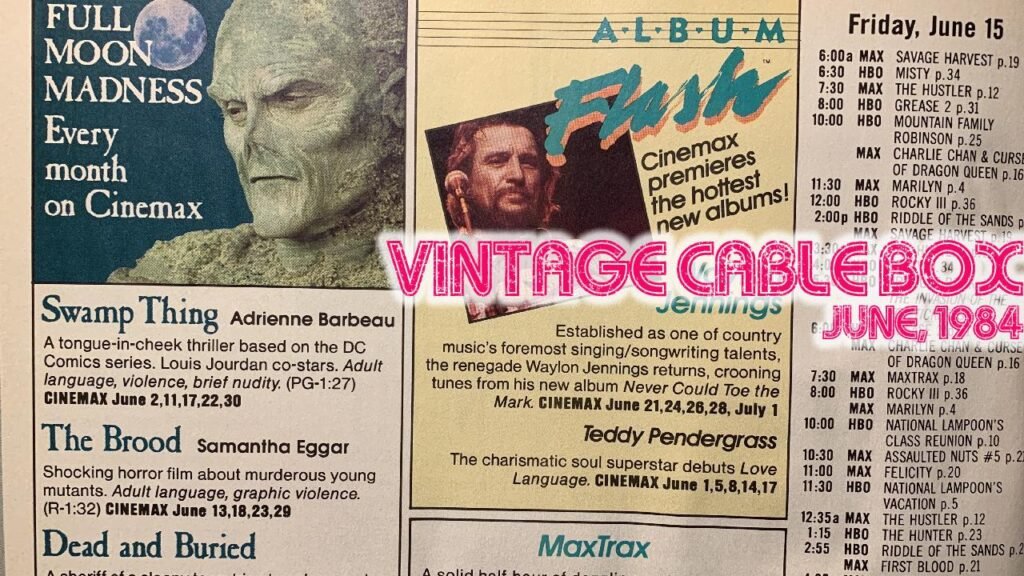
Swamp Thing, 1982 (Adrienne Barbeau), Embassy Pictures
“Much beauty in the swamp, if you only look.”
Sultry government agent Adrienne Barbeau arrives in the Louisiana bayou to investigate Dr. Alec Holland’s (Ray Wise) experiments in bio-engineering with his sister, Linda. Holland has just made a major breakthrough. Louis Jourdan plays Arcane, a rival scientist who orders his men to attack Holland’s compound and steal his new formula. In the resulting firefight, Holland is contaminated with his formula and disappears in the swamp, presumed dead.
Later, when Jourdan’s men try to kill Barbeau, Swamp Thing emerges to dispatch them. Released a good three months before Creepshow, Swamp Thing adopts the same comic-book-within-a-movie visual sense, even down to the turning of pages and artwork panels for scene transitions. Craven’s screenplay is intelligent with a sense of humor and the performances (particularly those of Wise, Barbeau, Jourdan, and Dick Durock as the titular hero) are wonderful.
Based on Len Wein and Bernie Wrightson’s DC Comics series, the movie was made on an astonishingly low $3 million budget. Henry Manfredini’s score recalls his work on the Friday the 13th franchise, with stings and twists, and Bernard Hermann-like trills. The editing is breakneck in the action sequences and appropriately slow in the more romantic and menacing scenes.
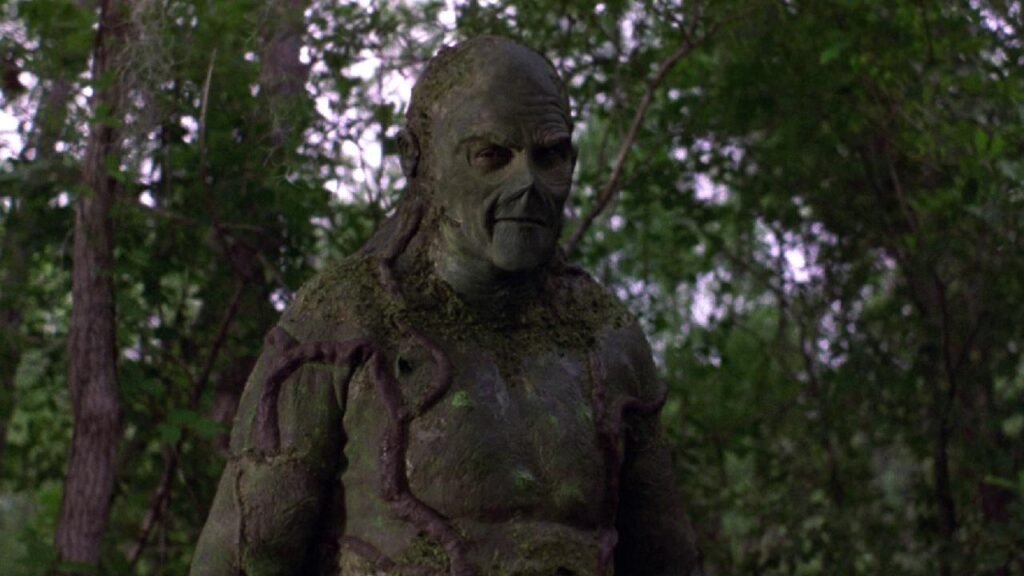
The creature itself is a marvel, created by Bill Munns, who would also contribute ghastly creatures for The Return of the Living Dead. Swamp Thing is schlocky and pulpy and pure fun to watch. The early eighties were a time when filmmakers, presumably working on the edge of the mainstream and outside of the borders of studio control, started getting bigger budgets.
Wes Craven was primarily known for Last House on the Left and The Hills Have Eyes. Swamp Thing was his formal introduction to studio work. This was the same year Tobe Hooper made Poltergeist and George Romero made Creepshow, so a definitive New Horror renaissance had taken place. Scream Queen Adrienne Barbeau appeared in John Carpenter’s The Fog and Escape From New York and would later appear in Creepshow.
Ray Wise would later star in Robocop and Twin Peaks (the television series and the movie). Stuntman Dick Durock appeared in the sequel, The Return of Swamp Thing and the spin-off television series, which ran for 72 episodes. It’s impossible to estimate Wes Craven’s impact and influence on the modern horror movie. A creative thinker and intuitive director, Craven created intelligent horror movies that did not skimp on scares.
After Swamp Thing, he would create one of the most popular franchises that rivaled only Jason with A Nightmare On Elm Street. The People Under The Stairs is my wife’s favorite movie of Craven’s. In 1996, he directed Kevin Williamson’s popular post-modern slasher movie, Scream, which yielded three sequels.
The Brood, 1979 (Oliver Reed) New World Pictures
“I’ll kill Candice before I let you take her away from me.”
I’d love to know what goes on in David Cronenberg’s head. No. Scratch that. I need to know what goes on in his head. We had a rare occasion in the house where some special interests lined up. The movie of the night was Existenz, Cronenberg’s 1999 virtual reality thriller starring Jude Law and Jennifer Jason Leigh. I hadn’t seen it in over twenty years.
I remember stuffing wedding invitations into envelopes while watching it, so maybe I was distracted. Just when I thought I had everything figured out, Cronenberg’s ambiguous ending deliberately caused me considerable confusion. I don’t mind, though. Cronenberg was, and continues to be, an extraordinary storyteller. He works alone, or as far away from the studio system as possible, and it shows.
Halfway through Existenz, I asked my wife if any notes would change hands at writer’s meetings during the making of this kind of movie. We couldn’t imagine. Nearly 25 years later, Cronenberg is still an incredible filmmaker with a uniquely personal vision. Twenty years earlier, he made The Brood starring Oliver Reed, Samantha Eggar, and Art Hindle. Architect Hindle’s deeply disturbed ex-wife (Eggar) is undergoing radical treatment from Reed called “psychoplasmics.”
Meanwhile, he’s fighting a tug-of-war battle with the court over custody of their daughter, Candice (Cindy Hinds). Even though his ex-wife shows signs of dangerous mental instability and repressed violence, the court tends to favor the mother in divorce cases. After his daughter’s grandmother dies under mysterious circumstances in front of the child, Hindle suspects his ex-wife may be involved, so he seeks to discredit “psychoplasmics,” even though based on some of Cronenberg’s shots, it appears to be a psychotic child, who dies after trying to attack Hindle.
The cops think a deranged mother locked the child in the attic of the house and never told anyone, and that the isolation caused the child to go feral. That’s a great theory, and it’s better than most, but the coroner notes that the child had no navel. So how could it have been born? It looks more like a bipedal creature than anything resembling human. Cronenberg taps into ideas and situations that make us squeamish and ill-at-ease.
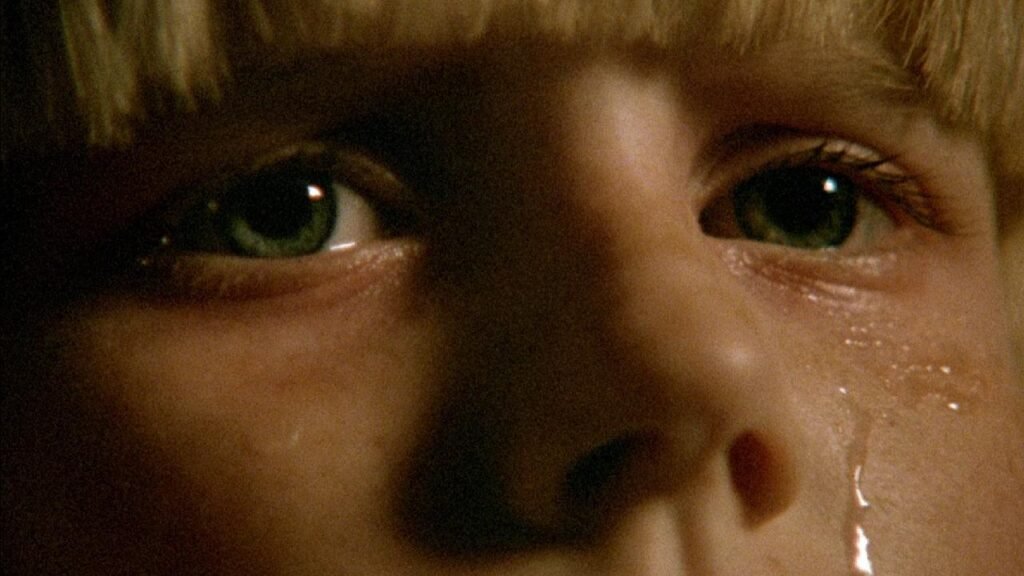
I think he views the human body or framework as a violent vessel, capable only intermittently of love and tenderness. It’s a through-line that has lasted for decades in his work. Is it possible (in his estimation) we only use our bodies to experiment with love, rather than embrace it? Are we (as Burroughs would put it) simply soft machines? It’s no coincidence that the bodies he imagines turn against us in demonic, yet scientific ways.
I could tell, watching The Brood, and Videodrome, and Scanners, and Rabid, and Existenz that he enjoys playing games with the brains and innards of his characters. It’s known as body horror and, even when we don’t see the torture of the body, we do see the torture of the mind. There is some creepy imagery at play. There’s a scene that takes place during kindergarten where more of these little child freaks murder the teacher in front of the other children, who are appropriately traumatized. Jesus!
After killing the teacher, they abduct Candice, and now the cops are looking for “dwarf killers.” Except these aren’t dwarves, and all of this is connected to his ex-wife, “psychoplasmics,” and a work shed out in the woods where the rest of the brood waits. Basically, Eggar’s violent rage has caused the asexual birth of these creatures. Whoa! I mean … okay. This was an insanely disturbing movie even before the revelation of Eggar’s motherhood.
Cronenberg was going through a bitter divorce from his first wife at the time, and like any artist, he put his misery on paper. Andrzej Żuławski did the same with Possession from 1981, although his treatise was crueler than Cronenberg’s, who operates from a place of pity and confusion more than anything, but he was a relatively young man at the time. This is a chilling, somewhat depressing drama that masquerades as a horror film.
Album Flash/MaxTrax, 1984 (Waylon Jennings/Teddy Pendergrass) Cinemax
Album Flash was an interesting experiment at a time when music videos were exploding all over the pop culture. MTV had been around for a little over two years. We already had Michael Jackson’s Thriller, the Godley & Creme big-budget mini films with musical accompaniment of “Girls on Film,” “Every Breath You Take,” and Herbie Hancock’s amazing “Rockit.”
MaxTrax was Cinemax’s version of HBO’s Video Jukebox; “a solid half-hour of dazzling rock videos” according to the description in the guide. MTV, at the time, wasn’t available in all cable markets, so HBO and Cinemax had their own shows devoted to music videos. If you didn’t have cable television, there was Friday Night Videos on NBC right after Letterman.

There was also Night Flight, Solid Gold, and Video Music Box (which played on Channel 17 in Philadelphia every night at 7PM). Album Flash focused on the current release of an album from an established musician. Episodes were devoted to The Go-Gos (and their current release, Talk Show), Phil Collins’ No Jacket Required, and Paul Simon’s Hearts and Bones, among others.
The show was inexplicably cancelled after only one year. This is back when musicians actually sold records. The only reason I can come up with is younger viewers weren’t interested because the episodes were shot like free-form documentaries with performances scattered throughout. They weren’t made for short attention spans. The Waylon Jennings and Teddy Pendergrass episodes were similar in theme because both artists were in a state of recovery and rehabilitation.
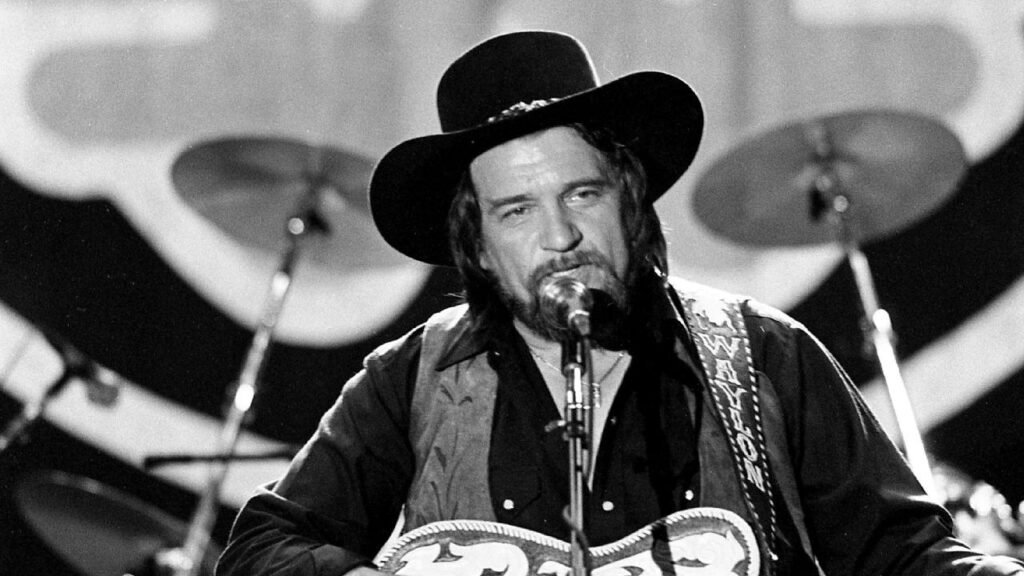
Pendergrass had been paralyzed from the waist down after a car crash in Philadelphia in March of 1982. He recorded Love Language during his rehab. The song, “Hold Me,” is a duet with Whitney Houston, and her first single, prior to her debut album, which would be released the following year. As a matter of fact, the first time I saw her video for “How Will I Know,” it was on Video Jukebox. She was so young and sweet back in those days.
Waylon Jennings was in withdrawal from a serious addiction to cocaine around the time of recording Never Could Toe the Mark. We knew him as The Balladeer from The Dukes of Hazzard. He sang the theme song and did the voice-overs. The album flopped (even on the country charts) and Waylon wouldn’t have another hit until he changed labels and moved over to MCA Records in 1986 with Will the Wolf Survive.
Dead and Buried, 1981 (James Farentino) AVCO Embassy Pictures
“Call it black magic. Call it a medical breakthrough. I’ll take my secret to the grave.”
Who would’ve thought the kindly (lazy-ass) grandpa from Willy Wonka would become a mad scientist/Dr. Frankenstein-type who enjoys reanimating corpses while spouting sage platitudes and home-spun wisdom? Yes. Sorry to spoil it for you, but Charlie’s Grandpa Joe is EVIL! Something is wrong in Potter’s Bluff. From the looks of the cozy seaside town, it resembles Amity in the fictional world of Jaws, though the movie was shot in Northern California.
We even have a Chief Brody-type in James Farentino’s Sheriff Dan Gillis. It seems there’s a series of strange and gruesome murders of tourists. Has this happened only recently? Given the back-story (as it is revealed) this would have been happening fairly frequently, but Gillis seems genuinely surprised this keeps occurring. He takes it up with coroner Dobbs (Jack Albertson), who isn’t of any help and actually appears to be impeding Gillis’ investigation.
When Gillis grows suspicious of him, he asks for a background check only to discover Dobbs was fired from his last job for conducting bizarre experiments on corpses. What the … ? I imagine this to be a real Six Feet Under situation, especially as Dobbs marvels at his handiwork at making the most grotesque cadavers look alive again, but then we get the mad scientist angle.
It’s almost like the town is gaslighting this one man: the Sheriff. Adding to his woes is the unusual behavior of his wife, schoolteacher Janet (Melody Anderson, fresh from Flash Gordon). She keeps secrets from him and teaches her students about voodoo. I’m not sure if voodoo is a macguffin as Dobbs likens witchcraft to science, but it does keep you guessing as to how Dobbs is able to do what he does.
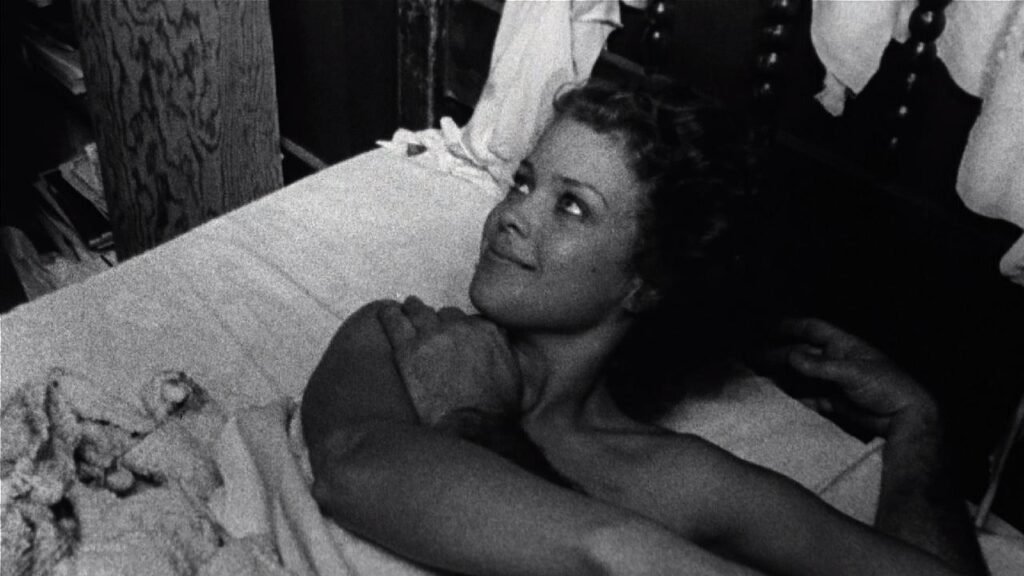
Even as he reveals his master plan, you half-expect him to jump in the air and sing, “I’ve got a golden ticket!” That would be adorable. Townies are revealed to have murdered the tourists in different ways while taking pictures of the victims. I was scratching my head at that detail, but then it occurred to me that morticians need photos of the bodies in order to restore them (thank you again, Six Feet Under), and the clever Ronald Shusett/Dan O’Bannon script provides some interesting easter eggs that nearly reveal Dobbs’ plan.
O’Bannon’s an interesting guy. In a 1983 interview, he disowned the script, claiming he had no hand in Shusett’s rewrites, but later he appears in blu ray supplements in a 2003 interview to discuss his contribution. Basically, Grandpa Joe is reanimating corpses, and the results are remarkable. The entire town of Potter’s Bluff, including the Sheriff and his wife, are composed of reanimated corpses!
This was before morphing and the age of CGI. Stan Winston’s stunning makeup work is enhanced by some very simple dissolves. Director Gary Sherman does a fine job, but I think the script makes the mistake of revealing the townies too early, as well as giving us too much information as the murders occur.
I felt it should’ve been ambiguous at the beginning, and then have the revelations of the killers escalate until the end when it becomes justifiable for Sheriff Gillis to have his breakdown. As it happens with the editing, Gillis goes nuts a half an hour into the movie, and his tantrums and bad humor are almost unintentionally funny. I wish my girl Melody had more to do, but I guess she can’t save the universe in every single movie. Happy Halloween!
Our first cable box was a non-descript metal contraption with a rotary dial and unlimited potential (with no brand name – weird). We flipped it on, and the first thing we noticed was that the reception was crystal-clear; no ghosting, no snow, no fuzzy images. In June of 1984, HBO and Cinemax broadcast an incredible, eclectic assortment of movies. Vintage Cable Box returns to highlight each of those movies, as well as offering new appraisals and providing context into what was cable television in the mid ’80s. It was a different cultural landscape at the time, and these movies offered an education that went far and above film school. Vintage Cable Box explores the wonderful world of premium Cable TV of the early eighties. Enjoy!
Special thanks to Dave Hooser for scanning the HBO/Cinemax guide and sharing these pictures.

